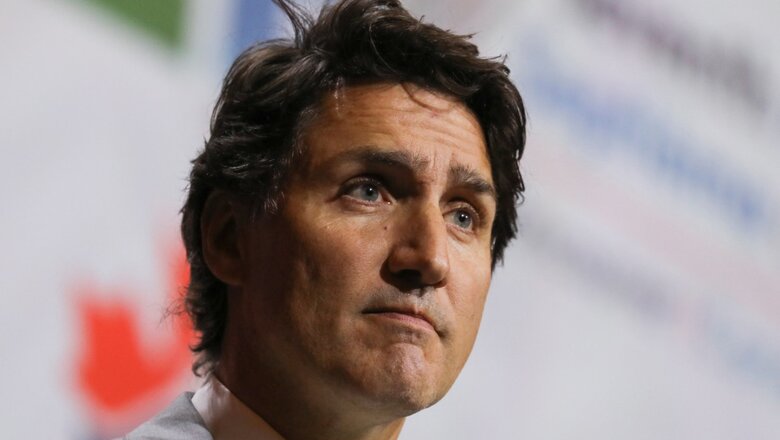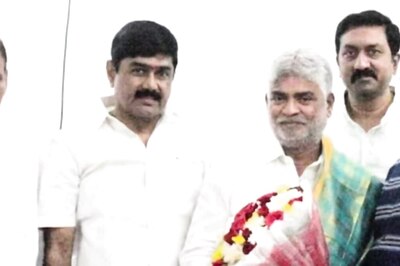
views
The more one ponders over Justin Trudeau’s hitjob against India, the more it becomes obvious that he may not be the only player in the sinister game to corner New Delhi. He, in fact, may not be the main player either. This is despite the fact that Trudeau was upset at being ignored at the recently held G20 Summit hosted by India. He was also snubbed by Prime Minister Narendra Modi for Ottawa’s dubious Khalistani connections. Of course, he finds himself trailing in Canadian politics and wants to catch up with his opponents by raising an emotive issue. And yes, he has an unsavoury Chinese connection for which the ruling Liberal Party is facing a probe.
Still, Trudeau resurrecting an India ghost in the assassination of a Canadian national, Hardeep Singh Nijjar, a known Khalistani terrorist, has all the ingredients of Western deep state connections. More so as it comes soon after India upscaled its global stature post-G20 presidency. The suspicion gathered steam when a New York Times report on Sunday, 24 September, stated that US spy agencies reportedly provided information to Canada on Nijjar’s killing, which took place this June. According to the report, American agencies offered their Canadian counterparts context that helped Ottawa conclude that New Delhi was involved in the killing. Interestingly, following Trudeau’s outburst, the United States has urged India to cooperate with Canada in its investigations.
One wonders if Trudeau was hoodwinked by American agencies which, as per NYT, provided Canada with some information on Nijjar’s killing. Maybe that was the reason why Trudeau, mistakenly and foolishly assuming it to be the US support for Canada, could go as far as he went this time, accusing India of extra-territorial killing. But then, the Americans apparently didn’t share any specific details; it was, as the NYT report says, just the “context”, which Trudeau badly misinterpreted to push the Indo-Canadian ties to a new low.
One may wonder why the US would try to corner India soon after the Modi-Biden bonhomie at the G20 Summit in Delhi. The answer may lie in what Gautam Sen wrote in one of his articles for Firstpost, ‘Why West is so uncomfortable with rising India and happy to sponsor its enemies’ (July 18, 2022): The Americans and their European allies “have uses for India but no real camaraderie or commitment towards it”. One can sense the Western unease with the rising, new India from the kind of bad press the latter gets on a daily basis in the Euro-American media.
However, before falling into anti-American trappings, one needs to understand that a country’s foreign policy is largely governed by its national interest. The West, especially the US, while acknowledging India’s utility, especially against growing Chinese threats, believes that a strong Delhi would ultimately propel out of its orbit of influence. While the West is within its right to forward its agenda, India too should wisely mix its geostrategic advantages and economic leverages to push its national interest.
However, what’s disconcerting is the American (Western) tendency to compromise long-term interest for flippant, short-term gains. The ongoing Ukraine war is a case in study where the US sacrificed its long-term objective of creating a larger, stronger coalition against growing Chinese hegemony by obsessively focusing on the immediate — of fixing Vladimir Putin, who, if the Americans had handled him with the maturity of a sole superpower, could have been a valued ally against Xi Jinping’s pernicious designs.
Coming back to the core issue, this fear of India becoming “too big to control” often turns the West into a frenemy. It would hug India one moment and in the next, it would look for reasons to corner it with issues, real or imagined. It both admires and abhors India, often simultaneously. This is a Western way of having the cake (India’s support vis-à-vis China) and eating it too (constantly finding issues to corner Delhi).
Khalistanis, for that matter, are a mere tool for the West to keep New Delhi “engaged”, just the same way they have been used by Pakistanis to push their balkanisation plan. A glance at the official map of Khalistan, published by Sikhs For Justice (SFJ), led by Gurpatwant Singh Pannun, one of the top Khalistani leaders who practices law in New York, would show how the entire endeavour has been less about Sikh identity and aspiration and more about hitting out at India. The official Khalistani map, for instance, incorporates not just the Indian state of Punjab, but also the whole of Haryana, Himachal Pradesh and the National Capital Territory of Delhi; Khalistanis also claim a large part of Rajasthan.
The map is ludicrous on two counts. One, Khalistanis are seeking overwhelmingly non-Punjabi states for the creation of a Punjabi nation. Except Punjab, all other Indian states claimed by Khalistanis have minuscule Sikh presence. Haryana has 87 per cent Hindus; Delhi has 81 per cent Hindus; Himachal Pradesh has 95 per cent Hindus, while in Rajasthan there are 88 per cent Hindus.
Even more ludicrous is the Khalistani generosity not to seek any territory from Pakistan, despite the presence of a number of historical and religious sites of Sikhs on the other side of the border. The Khalistani reverence for the Radcliffe Line is so absolute that nothing is sought from Pakistani Punjab — not even Lahore, which was the erstwhile capital of Maharaja Ranjit Singh. Even the holy Nankana Sahib, the birthplace of Guru Nanak, is voluntarily excluded from the Khalistan map. The very fact that the Khalistanis want Delhi and not Lahore exposes the real, pernicious agenda of the movement for the so-called nation of the Sikhs.
One finds the West-Pakistan nexus from the very beginning of the Khalistani misadventure. The founder of the Khalistan ‘movement’, Jagjit Singh Chauhan, was in Pakistan soon before setting up this terror group. During his stay there, he was warmly received by Gen Yahya Khan, the country’s military dictator then. After this, he went to New York and on 12 October, 1971, came out an advertisement in The New York Times proclaiming the birth of Khalistan. “We are going to wait no more,” the ad said. “Today we are launching the final crusade… We are a nation in our own right.” The Pakistan Embassy was believed to have paid for that ad on American soil!
After the humiliation in the 1971 war, which saw the birth of a new country called Bangladesh, the Pakistani aspiration to balkanise India got a new, revenge angle too. Zulfiqar Ali Bhutto, who took over from Gen Yahya Khan, inherited the Khalistan project too and added to it the Pakistani rage for revenge. As a young journalist in 1973, Tarek Fatah, the late Pakistan-born, Canadian journalist, heard Bhutto pledge at an off-the-record briefing to carve out a piece from India – Khalistan – to avenge 1971. “Pakistan will also have a Bangladesh, carved out of India,” Fatah quoted Bhutto as saying, “except it will be on Pakistan’s border.” It also made geostrategic sense: For, once Khalistan was accomplished, then Kashmir, geographically cut off from the rest of India, would be there for the taking!
Be that as it may, the fact is India and the West, especially the US, need each other for their own interests, and also for the sustenance of the liberal world order, currently under threat from Xi Jinping’s China. Agreed, the two have a few commonalities and some differences, which may explain why India and the US may not be allies in the way the Americans and Europeans are, but they have to be friends for the liberal world order to remain ‘liberal’ and ‘ordered’. And for that, the US-led West has to draw a line on patronising anti-India elements in the West.
Views expressed in the above piece are personal and solely that of the author. They do not necessarily reflect News18’s views.


















Comments
0 comment